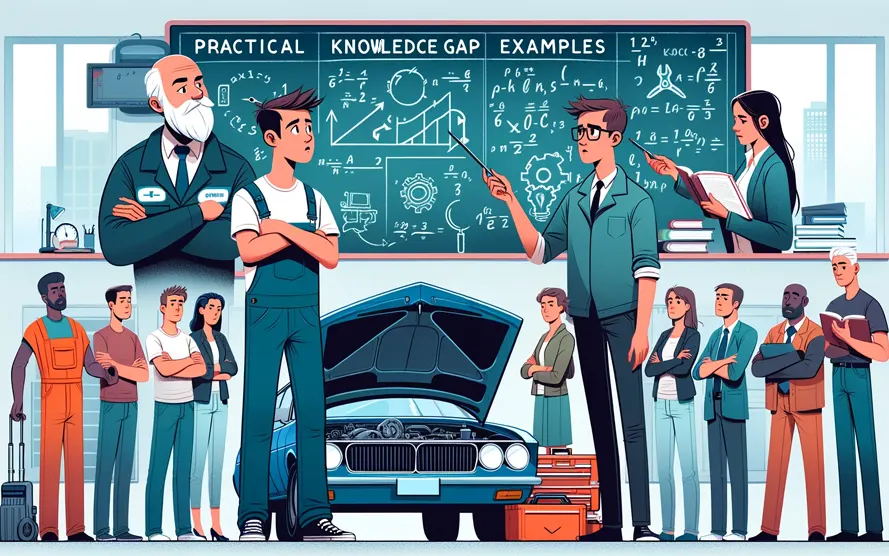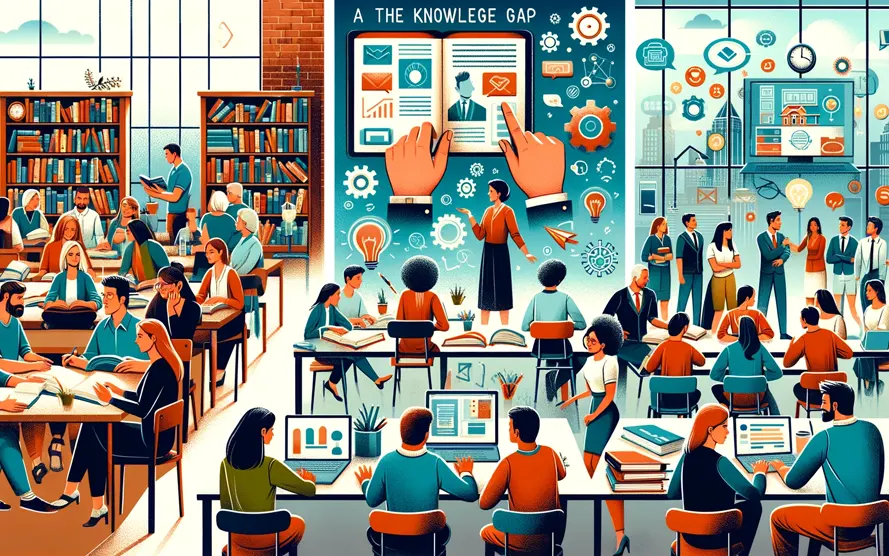In the vast realm of knowledge, there are inevitable spaces of non-understanding, identified as knowledge gaps. But what is a knowledge gap in essence? How can it be utilized in various industries such as business? This article aims to thoroughly delve into the knowledge gap definition, its implications, and how it is used in different contexts.

Understanding the Knowledge Gap
A knowledge gap is the chasm between what is known and what is yet to be known. It’s that void of unanswered questions, unexplored ideas, and undiscovered truths. In a nutshell, it’s the difference between what we know and what we don’t. Whether it be in academia, business, or our personal lives, knowledge gaps persist everywhere.
The Theory Behind the Knowledge Gap
The knowledge gap theory postulates that in a society, this void of knowledge isn’t distributed equally. Essentially, people with higher socio-economic status acquire information at a faster rate than those with a lower socio-economic status. This phenomenon widens the knowledge gap, and as a result, a disparity in knowledge exists among different sections of the population.
The Meaning of Knowledge Gap
So, knowledge gap meaning extends beyond just a deficit of information. It refers to the lack of awareness, understanding, or competency in a particular subject. These gaps may manifest in various aspects of our lives such as in our skills, cultural understanding, or technological savvy.
Knowledge Gap Hypothesis: A Closer Look
Diving deeper, the knowledge gap hypothesis proposes that when new information enters a social system, individuals with better socioeconomic status tend to absorb this information quicker. Over time, this differential speed of absorption leads to a wider gap in knowledge meaning that information disparity among different groups within a society increases.
Practical Knowledge Gap Examples
To understand this concept better, let’s look at a few knowledge gap examples in real-world scenarios:
- In Education: A student might have a solid grasp of calculus but struggles with geometry. That struggle represents a knowledge gap in the student’s understanding of mathematics.
- In Business: A manager might be adept at handling in-person meetings but falters at leading virtual meetings. This is a knowledge gap in their management skills.
- In Society: A community might be well-versed with traditional farming techniques but lacks understanding of modern, sustainable agricultural methods. This indicates a societal knowledge gap.

The Process of Knowledge Gap Analysis
Identifying these gaps is the first step towards filling them, and knowledge gap analysis is the tool for the job. It’s a systematic process used to identify the gaps in skills, knowledge, and capabilities between the current and desired state. This process helps individuals, teams, and organizations to identify what they need to learn and develop to improve performance and achieve their goals.
The Rationale Behind Knowledge Gap Analysis
By pinpointing the areas of deficiency, knowledge gap analysis allows for targeted learning, development, and growth. It helps to map out a clear plan of action to eliminate these gaps and foster the optimal utilization of resources. The ultimate aim is to ensure a smooth and effective path towards the achievement of the desired state of knowledge or skillset.
Knowledge Gap in Business: An Integral Concern
The role of the knowledge gap in business is a crucial one. Companies that consistently perform knowledge gap analysis can identify gaps in their market understanding, strategic planning, or employee skills.
Market Understanding
Companies must understand their customers’ needs to provide relevant and valuable products or services. If a business is unaware of these needs, a knowledge gap exists which can negatively impact the business’s market competitiveness.
Strategic Planning
Strategic planning involves defining an organization’s direction and making decisions on allocating resources to pursue this strategy. A gap in understanding market trends, competition, or internal capabilities can lead to ineffective strategic decisions.
Employee Skills
Employees need the right skills to perform their jobs effectively. A knowledge gap in a critical skill area can lower employee productivity and hamper the business’s growth.
How to Address the Knowledge Gap?
Addressing knowledge gaps isn’t about amassing all the knowledge you can lay your hands on. Rather, it’s about honing in on the gaps that truly matter to your context. Here are some strategies for addressing knowledge gaps:

- Identify the Gap: Use tools like SWOT analysis, skills assessments, and feedback mechanisms to identify where the gaps exist.
- Prioritize: Not all gaps need immediate attention. Prioritize based on the gap’s impact on your goals.
- Create a Learning Plan: Based on your priorities, create a learning plan that includes resources, timelines, and measurable objectives.
- Implement: Put the plan into action and start learning.
- Review: Regularly review and adjust your plan as needed to ensure that you’re making progress towards filling your knowledge gaps.
In Conclusion: The Power of Recognizing and Addressing Knowledge Gaps
Understanding what is a knowledge gap and acknowledging its existence is the first step in the journey of learning. Recognizing that these gaps aren’t signs of inadequacy but opportunities for growth can drive a culture of continuous learning and development, be it in an individual, team, or an entire organization.
So, take a moment and ask yourself: “What don’t I know?” The answer might surprise you, but it is these surprises that illuminate the path to learning and growth. After all, in the pursuit of knowledge, the journey is just as important as the destination.


